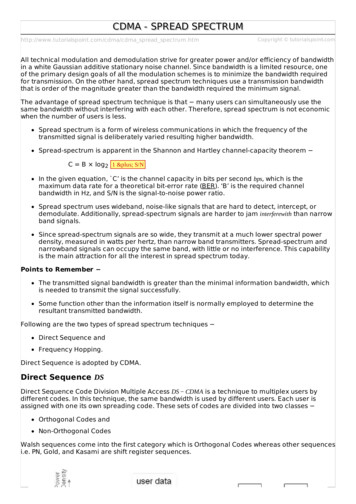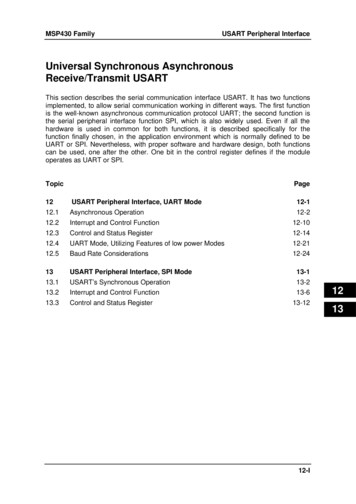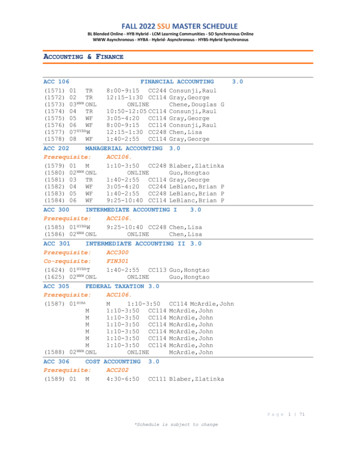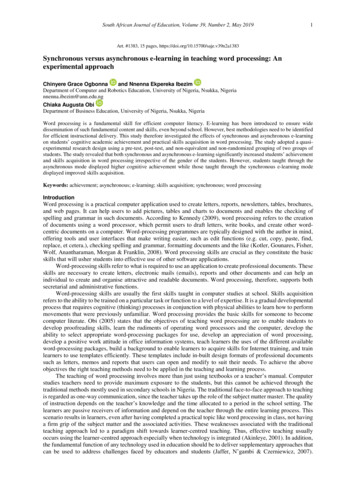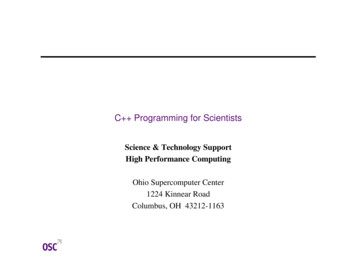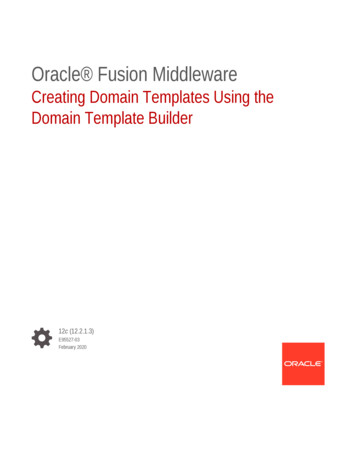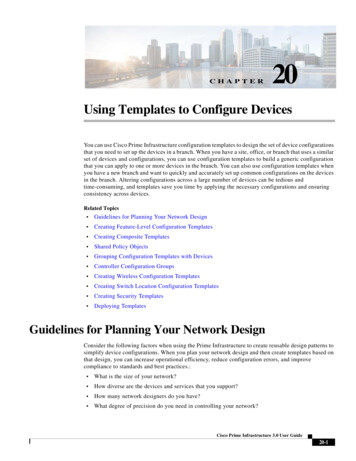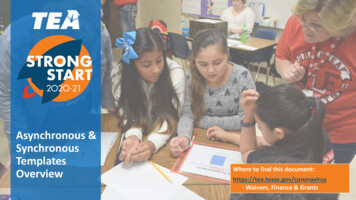
Transcription
Asynchronous &SynchronousTemplatesOverviewWhere to find this document:https://tea.texas.gov/coronavirus- Waivers, Finance & Grants
Section 1RECAP: Synchronousvs. AsynchronousMethods forAttendance2
RECAP Method A: Synchronous instruction is very similar to “oncampus” Defined as two-way, real-time, live, instruction between teachers and students,through the computer or other electronic devices or over the phone A minimum number of daily minutes are required to earn full-day funding (cut in halffor half-day funding) 3rd through 5th grade – 180 instructional minutes 6th through 12th grade – 240 instructional minutes PK - 2nd grade are not eligible to earn funding through the synchronous model. (School systemscould support these grades via the asynchronous method.) Teachers take and post attendance at a specific schedule, just as with on-campus ADA,documented as “Present-Remote Synchronous” in SIS for PEIMS reporting LEAs must submit an attestation that they are prepared to offer synchronousinstruction3
RECAP Method B: Asynchronous instruction involves far moreself-guided student instruction Defined as a curricular experience where students engage in the learning materials on their owntime, interacting intermittently with the teacher via the computer or other electronic devices orover the phone Eligible for all grades, generates full-day funding for each day “engaged,” assuming (forsecondary) that a student isn’t scheduled to participate in less than a half-day’s worth of courses,and half-day funding for PK students as normal If students are engaged for the day, they would be marked as “Present-Remote Asynchronous” inSIS for PEIMS. Engaged is any of these three: Progress (as defined in the approved learning plan) in the Learning Management System (LMS) madethat day Progress (as defined in the approved learning plan) from teacher/student interactions made that day Turn-in of assignment(s) that day LEAs must apply to receive the waiver, by submitting a plan to TEA for approval4
Schools can offer either or a mix of both synchronous andasynchronous remote instruction. All students at all grade levels (including PK-2) need direct instruction andsynchronous support from teachers The attendance funding methods are set-up to provide flexibility, so thatschools can provide the right mix of synchronous and asynchronous remoteinstruction for their students It is possible for an LEA offering these remote methods that the sameindividual student could generate daily attendance funding over the courseof the year in more than one way (on campus, synchronous, asynchronous). For any given day, if attendance is taken at the approved time and the minimum number of minutes aremet, that qualifies as Present – Synchronous. But synchronous instruction for a shorter number ofminutes and/or outside the designated synchronous attendance time can and still should happen regularlyas part of an asynchronous plan.5
Section 2SynchronousInstructionAttestation6
Districts must complete an attestation for synchronousinstruction. District attestation must be completed by Labor Day (9/7) This process will require the superintendent & board to attest to eachof the following statementsAll rules for remote instruction will only apply for the 2020-21 year.More permanent changes related to remote instruction policy will be decided by the legislature.7
Synchronous Instruction - AttestationsStudent and Family Support Districts ensure that all students, including students with disabilities and English learners (ELs), areable to receive instruction via synchronous methods and provide accommodations or resources tosupport when necessary. Student IEPs are followed regardless of learning environment such that students with disabilitiesreceive a Free, and Appropriate Public Education (FAPE). Families and students are provided with clear communications about expectations and supportfor accessing and participating in synchronous instruction Families are aware of options for transferring between instructional settings and the design of thesynchronous remote options allows for transitions to occur with minimal disruption to continuityof instructionEducator Support Educators are trained and supported to do synchronous instruction on the district chosenplatform, including practice with the platform prior to delivery with students. Educators receive ongoing, job-embedded support to continuously improve their practice in thesynchronous remote setting.8
Synchronous Instruction - AttestationsTech Support and Access District IT staff are trained on the platform and can troubleshoot access issuesfor parents and students when issues arise. A helpdesk or other support lineis accessible for parents and students for this purpose. Consistent, daily platform is identified by the district for delivery ofinstruction to students Educators have technology equipment that allows them to deliversynchronous remote instruction including proper internet bandwidth anddevices with enabled cameras and microphones.9
Synchronous Instruction - AttestationsInstructional Framework Curriculum is fully aligned to the TEKS and designed to ensure all TEKS arecovered by the end of the year Instructional schedule meets the minimum number of daily minutes to meetfull day funding: 3rd through 5th grade – 180 instructional minutes 6th through 12th grade – 240 instructional minutes PK - 2nd grade are not eligible to earn funding through the synchronous model. School grading policies for remote student work are consistent with thoseused before COVID for on campus assignmentsFinal Attestation The Superintendent and the Board attest that these commitments are beingmet as of the date the attestation is submitted.10
Section 3The AsynchronousInstructionPlan Template11
The asynchronous instruction plan process has beendeveloped to provide flexibility and support to LEAs. We have attempted to balance the needs of our school systems for flexibility togenerate predictable funding with the need of taxpayers for accountability thatinstruction is being provided to students. TEA has attempted to craft a framework that provides maximum grace to allowtime to transition for the new school year while maximizing funding stability. LEAs may submit a plan as consortia. TEA will be providing exemplars, trainings, and free resources to support plandevelopment.All rules for remote instruction will only apply for the 2020-21 year.More permanent changes related to remote instruction policy will be decided by the legislature.12
LEAs must submit an asynchronous letter of intent and will enter agrace period through the end of the 3rd Six Weeks FSP PeriodLetter of IntentInitial PlanSubmissionTEA ReviewProcess Submit letter of Plan link avail: TEA reviews withinintent to submit aJuly 20th30-45 days of planplan prior to thesubmission LEAs shouldfirst day of remotesubmit by Oct. 1 Results in either:asynchronousto provide time Plan Approvedinstructionfor review, Notice of LOI link availablerevisions, andrevisionsJuly 9thapproval by 4thneededSixWeeks Results in:ContingentapprovalResubmissionand Review LEA submitsrevisions within 30daysGracePeriod Ends End of 3rd SixWeeks ReportingPeriod TEA final review Funding forwithin 15-30 days ofasynchronousresubmissionremoteattendance Results in either:stops without Plan Approvedapproved plan Plan NotApprovedNote: Letter of Intent & Initial PlanSubmission details have been updated13
Letter of Intent for Asynchronous Instruction LEAs must submit a Letter of Intent (LOI) prior to the first day of asynchronousinstruction in order to receive contingent approval that will last through the end ofthe grace period The letter of intent will be submitted through a survey link with the followingquestions: Do you intend to develop and submit an asynchronous instruction plan? Have you read and understood the requirements for the asynchronous instructionplan? Optional (for TEA review planning purposes): When do you expect to submit a plan toTEA? LOI survey link will be shared on the TEA Coronavirus Website and sent outthrough a TAA on July 9th14
Asynchronous plans must address four key requirementsInstructional ScheduleMaterial DesignStudent ProgressImplementation15
Each requirement has a section that contains attestationsand open response Attestations require the district that to certify thatthey are providing that particular structure orsupport to students in lieu of minutes. Open response questions allow districts to providemore information and provide a framework thatwould allow for an audit mechanism. Districts maydraft or attach information in the online application.Open response questions will be evaluated on adraft rubric, looking for clear criteria.Plans will need to be posted publicly in addition to beingsubmitted to TEA through an online application.16
Instructional Schedule - Attestations Teacher interaction with students is predictable, sufficient to support schedule. Teacher availability for students (e.g. office hours schedule) is planned inadvance, predictable, sufficient for student progress, clearly defined, andpublished in the student syllabus. Students can access instructional support from teachers when needed, directinstruction is delivered by teachers, and students know how and when they caninteract with their teachers. Students are provided clear means to engage with academic material on a dailybasis. Student IEPs are followed regardless of learning environment such that studentswith disabilities receive a Free, and Appropriate Public Education (FAPE).17
Instructional Schedule – Attestations - Continued Student academic work ensures engagement that is equivalent to direct contentwork that a student would be engaged in over a normal school year. Asguidance, this direct work with academic content matches or exceeds thefollowing average daily minimums across all subjects: Half day PreK – 90 instructional minutes Full day PreK – 180 instructional minutes K through 5th grade – 180 instructional minutes 6th through 12th grade – 240 instructional minutes18
Material Design - Attestations District has adopted a full, TEKS-aligned curriculum can be executed in anasynchronous remote learning environment. This includes: Assessments that ensure continued information on student progress remotely Instructional materials that support a coherent, logical course sequence that reinforcesconcepts at appropriate times to ensure continuity of learning remotely Instructional materials consistently reinforce concepts at appropriate times to ensureretention of knowledge in asynchronous environments Instructional materials include specifically designed resources and/oraccommodations and modifications to support students with disabilities andEnglish learners in an asynchronous environment. There is a plan to ensure district adopted instructional materials are used duringinstruction and in the hands of students.19
Student Progress – Attestations Expected student progress in remote asynchronous learning is planned in advance, defined byday, and ties to the overall course coverage in the course syllabus. Daily, trackable student engagement exists to ensure curricular progress in asynchronouslearning. Curricular progress can be measured through any of the following means: Data from the Learning Management System (LMS) showing progress made that day Curricular progress evidenced from teacher/student interactions made that day Completion and submission of assignments planned for that day Districts have systems to measure academic progress of all students to inform instructionalpractice in an asynchronous environment. Progress monitoring includes all students and can be done in any proposed at-home scenario (digital or print) Student feedback is provided from instructor at least weekly in asynchronous learningenvironments including next steps or necessary academic remediation to improve performance. School grading policies for remote student work are consistent with those used before COVID foron campus assignments20
Implementation – Attestations Campuses plan for and implement professional development calendars with specific supportsfor asynchronous instruction. These include the following for educators: Provide introductory and ongoing content-focused, job-embedded training linked to chosenasynchronous curricular resources Cover all grade levels and content areas that are participating in asynchronous learning Develop content knowledge to help educators internalize the asynchronous curriculum and analyzeand respond to data with the use of the instructional materials Explicitly cover asynchronous remote instructional delivery and use of the asynchronous learningplatform and/or learning management system Districts provide explicit communication and support for families in order to supportasynchronous work at home.21
Open Response – FormatWe ask that each LEA (or consortium of LEAs) submit only one plan.When responding to open response questions, you will be able to: Upload a document or type responses into text boxes in the survey Check if the response applies to all grade levels or just certaingrade levels If you check certain grade levels, you will be able to describe orattach a plan just for those grade levels/bands checked, and you’llreceive another open response box to submit for additional gradelevels/bands22
Please check the grade levels for which these open responsedescriptions/attachments apply PK3PK4K12345 6789101112 While we ask that districtsonly submit one plan, you willbe able to share how yourplan varies by grade level,grade band, or subject areasin your open responses.23
Open Response – Answer or Attach in QualtricsDescribe the structure of your asynchronous schedule highlighting anydifferences by grade level and/or content area.Describe how your instructional materials support your asynchronousenvironment, including how all students can access instructional materials.Describe how you’re tracking student engagement and progress inyour asynchronous environment.Describe specific supports for educators and families to implementeffective remote asynchronous instruction.24
Districts will be asked to complete a final attestation and link towhere the plan is publicly posted. The Superintendent and the Board attest that this plan is beingexecuted as described, effective no later than the end of the graceperiod.25
Section 4AsynchronousInstructionPlan Rubrics26
Each open response question will be evaluated by trainededucators using a standardized rubric.Describe the structure of yourasynchronous schedule highlightingany differences by grade level and/orcontent area.Describe how your instructionalmaterials support your asynchronousenvironment, including how all studentscan access instructional materials.Describe how you’re tracking studentengagement and progress in yourasynchronous environment.Describe specific supports foreducators and families to implementeffective remote asynchronousinstruction.27
The review process involves multiple reviews from trainedreviewers, and the opportunity for LEAs to revise and resubmit All plans will receive at least two reviews from experienced educators whoare trained and normed on the rubric TEA staff will conduct a third review if there is significant variance betweenfirst and second reviewers, or if average score is close to cut-off forapproval, and will make all final approval/revision needed decisions Any plan that is not initially approved will be returned to the LEA withspecific feedback on improvements needed and a chance to revise andresubmit Plans will need to be submitted by Oct. 1st in order to allow for enough timefor revisions and resubmissions within the grace period.28
Instructional Schedule –RubricPoints Category1.1 Instructionalschedule outlinesexpected time forstudents to interactwith academiccontent.1.2 Instructionalschedule outlinesexpected time forstudents to interactwith teacher(s) andreceive instructionalsupport 0 PointsExpectation fordailyinteraction withacademiccontent is notclear,Or times fordailyinteractions arenot definedInstructionalschedule doesnot includeexpectations andpre-plannedtimes forteacher/studentinteractions andsupport 1 PointExpectations for daily interaction withacademic content is clearAnd times are defined for studentinteraction with academic contentBut it is not clear how all studentgroups and grade levels will have theopportunity to engage in approx. a fullday of academic content everydayExpectations and pre-planned times forteacher/student interactions are clearin instructional scheduleBut expectations and pre-planned timesfor teacher/student interactions isinadequate (e.g. less than 30 minutesper day) or does not considerdifferentiation (e.g. is not differentiatedfor students with additional learningneeds) 2 PointsExpectation for daily interaction withacademic content is clearAnd times are defined for studentinteraction with academic contentAnd it is clear that all student groups andgrade levels will have the opportunity toengage in approx. a full day of academiccontent everydayExpectations and pre-planned times forteacher/student interactions are clear ininstructional scheduleAnd expectations and pre-planned times forteacher/student interactions are adequatefor all studentsAnd expectations and pre-planned times forteacher/student interactions aredifferentiated for students with additionallearning needs29
Material Design – RubricPoints Category2.1 District has adopted afull, TEKS-alignedcurriculum that can beexecuted in anasynchronous remotelearning environment. 2.2 Instructional materials include specificallydesigned resources tosupport students withdisabilities and EnglishLearners in anasynchronousenvironment0 PointsTEKS-alignedinstructionalmaterials andassessments arenot namedOr it is unclearhow instructionalmaterials andassessment havebeendesigned/adaptedfor asynchronousinstructionIt is unclear howinstructionalmaterials have beendesigned to supportstudents withdisabilities and ELs 1 PointTEKS-aligned instructional materials andassessments are namedAnd there is clear research/evidencebase for how instructional materialsand assessment have beendesigned/adapted for asynchronousinstructionBut there is not a clearresearch/evidence-base for howinstructional materials will ensure acoherent, logical sequence of learningand consistently provide opportunitiesto reinforce concepts to improveretention of knowledge as studentsmove between learning environmentsInstructional materials include resourcesdesigned to support students withdisabilities and ELsBut it is unclear that there is a plan for allstudents with disabilities and ELs toreceive the needed support through theuse of the instructional materials 2 PointsTEKS-aligned instructional materials andassessments are namedAnd there is clear research/evidencebase for how instructional materials andassessment have been designed/adaptedfor asynchronous instructionAnd there is clear research/evidencebase for how instructional materials willensure a coherent, logical sequence oflearning and consistently provideopportunities to reinforce concepts toimprove retention of knowledge asstudents move between learningenvironmentsInstructional materials include resourcesdesigned to support students withdisabilities and ELsAnd it is clear that there is a plan for allstudents with disabilities and ELs toreceive the needed support through theuse of the instructional materials30
Student Progress – RubricPoints Category3.1 Daily studentengagement is defined,trackable, and includesexpectations for dailystudent engagementthat is consistent withprogress that wouldoccur in an on-campusenvironment3.2 There is a system fortracking studentacademic progress toinform instruction andproviding regularfeedback to students ontheir progress 0 PointsExpectations for daily student engagement is not definedOr there is not a clearsystem for tracking daily student engagementThere is not a clearsystem for trackingstudent academicprogressOr there is not a clearsystem for providingregular feedback tostudents on progress 1 PointExpectations for daily student engagement is definedAnd there is a system for tracking daily student engagementBut expectations for daily student engagement are lower than whatwould occur in an on-campusenvironment (e.g. only requirement isfor students to log in without anythingelse)There is a clear system for trackingstudent academic progressAnd there is a clear system forproviding feedback to students onprogressBut it is not clear that all studentswill receive regular (at least weekly)feedback on progress 2 PointsExpectations for daily studentengagement is definedAnd there is a system for trackingdaily student engagementAnd expectations for daily studentengagement are consistent withprogress that would occur in an oncampus environmentThere is a clear system fortracking student academicprogressAnd there is a clear system forproviding regular (at least weekly)feedback to all students onprogress31
Implementation – RubricPoints Category4.1 Professionaldevelopment foreducators is plannedand specific tosupportingasynchronousinstruction4.2 There is explicitcommunication andsupport for families inorder to supportasynchronous work athome 0 PointsThere is no pre-plannedcalendar for educatorswith specific supports forimplementingasynchronous instructionOr the professionaldevelopment calendardoes not include bothinitial and ongoing, jobembedded developmentopportunities There is not a plan for explicit communication ofexpectations and support for families specific toasynchronous instructionOr the plan does not have reasonable expectationsfor families (e.g. expectsfamilies to be primarydeliverer of instruction)1 Point2 PointsThere is a pre-planned calendar for educators with specific supports forimplementing asynchronous instructionAnd the professional development calendar includes both initial and ongoing,job-embedded development opportunitiesBut it is not clear how the professional learning will develop content knowledge tohelp educators internalize theasynchronous curriculum and analyze andrespond to data with the use of theinstructional materialsThere is a pre-planned calendar foreducators with specific supports forimplementing asynchronous instructionAnd the professional developmentcalendar includes both initial and ongoing,job-embedded development opportunitiesAnd it is clear how the professionallearning will develop content knowledge tohelp educators internalize theasynchronous curriculum and analyze andrespond to data with the use of theinstructional materialsThere is a plan for explicit communication for families specific to expectations forasynchronous instructionAnd the plan has reasonable expectations for family engagement/support of studentsBut the plan does not include additional supports, training, and/or resources forfamilies who may need additional supportThere is a plan for explicit communicationfor families specific to expectations forasynchronous instructionAnd the plan has reasonable expectationsfor family engagement/support of studentsAnd the plan includes additional supports,training, and/or resources for families whomay need additional support32
Rubric Scoring GuidePoints by RowWhat does it mean?Avg % Points(16 total points)0Did not show evidence of meetingrequirements1Demonstrates some evidence ofmeeting requirements, but needsimprovementLess than 75%Plan returned to LEAs for(0-11 total pts)revision with feedbackOr, less than 3 out of 4pts for any question2Demonstrates evidence of fullymeeting plan requirementsWhat does it mean?Approved75-100%(12-16 total pts)And, at least 3 out of 4pts for each questionAny question (two rows) not earning 3 points will require a district to revise andresubmit.33
Section 5ForthcomingResources34
FAQs, exemplars, and trainings are forthcoming July 7th – Questions will be addressed in a FAQ July 9th – Exemplar asynchronous instruction plans posted, LOI surveylink and Synchronous Attestation survey link available July 13th – Training webinars on asynchronous instruction plan available July 20th – Asynchronous instruction plan link available Sept. 7th – Deadline for Synchronous Attestation submission Oct. 1st – Recommended asynchronous instruction plan submission datein order to allow time for revision and resubmission within the graceperiod35
Plan Approved Plan Not Approved End of 3 rd Six Weeks Reporting Period Funding for asynchronous remote attendance stops without approved plan LEAs must submit an asynchronous letter of intentand will enter a grace period through the end of the 3 rd Six Weeks FSP Period Plan link avail: July 20 th LEAs should submit by Oct. 1 to provide time
